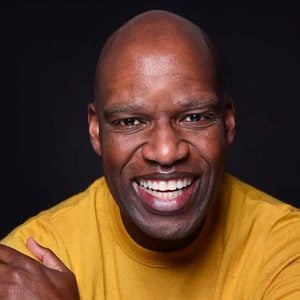In 2020, we received a record number 1,177 story submissions to our annual search for the Nicest Places in America as people struggled against a deadly pandemic and racial injustice. This year's winning place shows that when Americans unite, we can overcome anything.
Fighting COVID-19 and Racial Injustice, Buchanan, Michigan, Is the Nicest Place in America
Live in a place where people are nice and treat each other right? Tell us about it and your town could end up on the cover of Reader’s Digest!
Editors’ note: In a challenging year for America, when the COVID-19 pandemic and the evil of racial injustice pushed so many places to the brink, what set Buchanan, Michigan, apart? The 2020 Nicest Place in America is a town that would not be defeated by the coronavirus while uniting to say that Black lives do matter. It’s a place that has something to teach us all about caring for each other—even the least among us—not when it’s easy, but when it’s hard.
The Memorial Day parade in Buchanan, Michigan, isn’t the biggest in the country, but pound for pound these 4,300 residents might generate more red, white, and true-blue spirit than anywhere. Of course, there’s the boom-boom-boom of the high school marching band and the flashing lights of the police cars, fire trucks, and Buchanan’s one ambulance. One year, the town hitched its new rescue boat to a trailer to join the procession, where it dodged the usual caravan of red-hatted Shriners on mopeds. There are cheers all along the 1.4-mile route, for the floats and the kids and the candy and especially when the marchers pass under the 11-by-16-foot American flag casting its extra-large shadow over the intersection of Main and Front Streets.
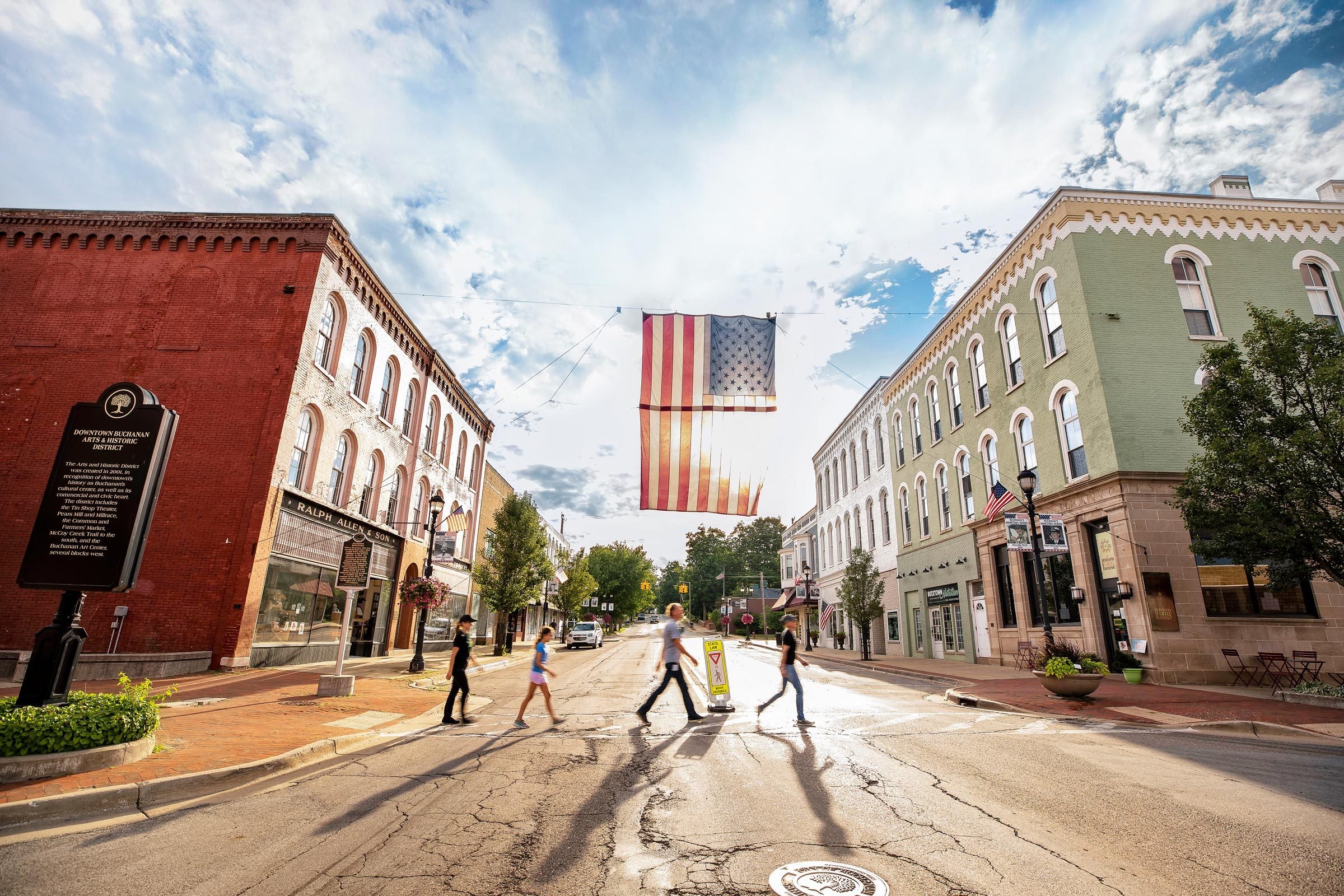
But this is also a day of remembrance, and when the parade reaches Oak Ridge Cemetery, the mood changes. The crowd grows quiet for the laying of wreaths on the graves of Buchanan’s war dead. Members of the American Legion fire a full 21-gun salute. Finally, the high school’s lead trumpeter plays taps. Buchanan has been celebrating the day since at least 1870, a full century before the nation established Memorial Day. In 2020, their almost 150-year-old tradition ended. “This year,” says John D. Van Dyke, a middle school science teacher who nominated Buchanan as the Nicest Place in America, “we weren’t able to honor our war dead.” The enemy: the COVID-19 pandemic.
At first, people were terribly disappointed. Yet this four-stoplight town has taught itself—and the rest of the country—a big lesson about kindness and patriotism and where the two join. Folks here face challenges head-on, but they’ve also discovered that being American is not about making a lot of noise and waving flags. It’s about honoring the First Amendment and finding new ways to help people make a living. And it means caring for your neighbor not just when it’s easy but also when a pandemic makes it very hard.
“I don’t want to give you the mistaken idea that this is Mayberry. We argue a lot because we care about everything,” says Mayor Patricia Moore. “This is where democracy lives.”
Buchanan is a classic Midwest town, a rivet in the buckle of Michigan’s rust belt. A huge smokestack, a reminder of the town’s industrial past, rises above low-rolling hills covered in forests. Winding country roads connect the small businesses along tree-lined Front Street with surrounding farms. South Bend, Indiana, home to the University of Notre Dame, is 16 miles to the southeast. Folks here root for the Cubs and the Bears, who play about 90 miles west, in Chicago.
So how did this ordinary-seeming hamlet become the Nicest Place in America? There’s no better example than what folks did after the parade was canceled—and the event that ended up taking its place.
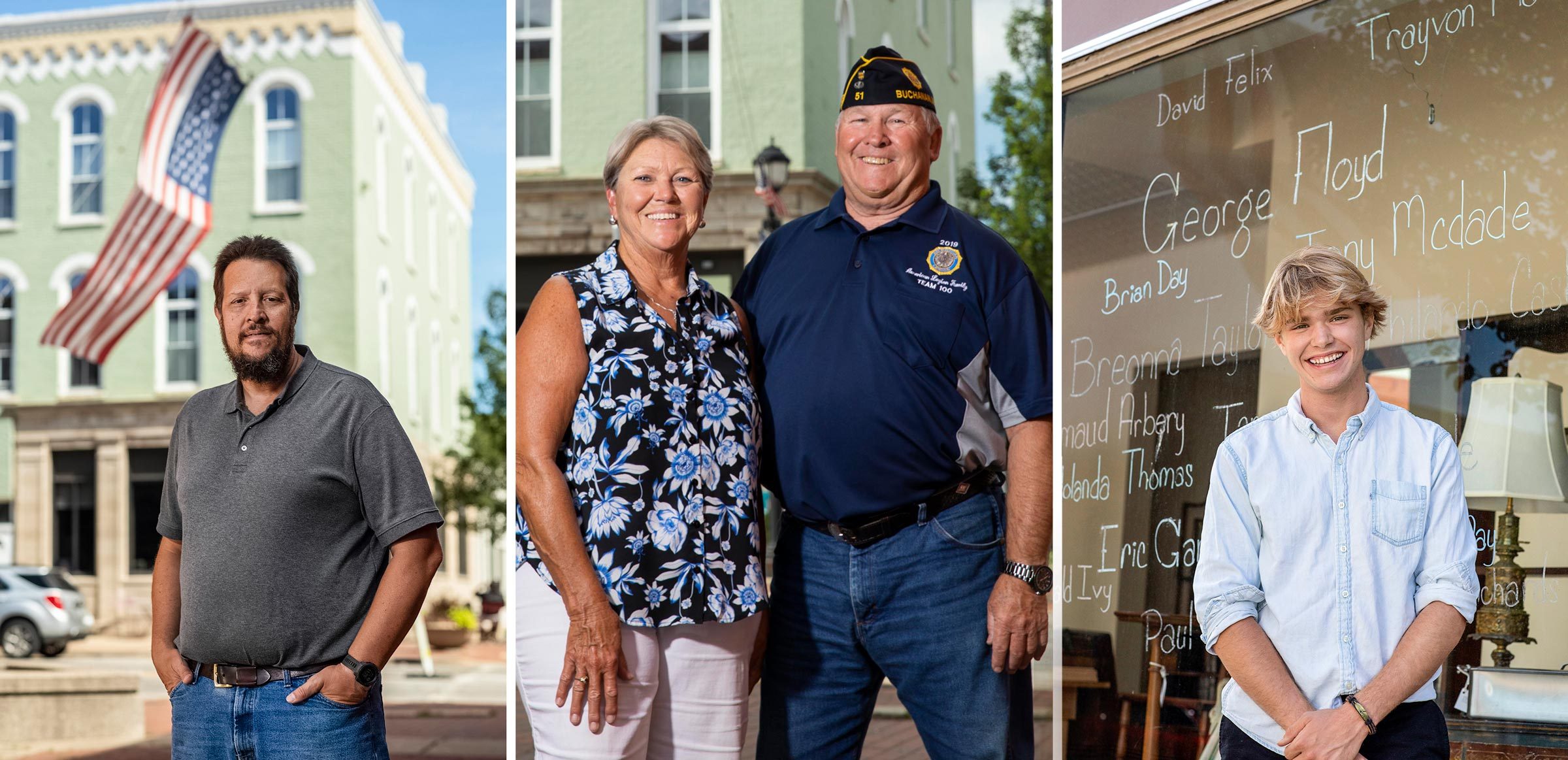
Memorial Day was also the day George Floyd was killed in Minneapolis. Although Buchanan has no recent history of police misconduct or racial strife, Deejra Lee, a 33-year-old Buchanan native, was sure that her neighbors would want to join the national call to action. After all, standing up and making noise is something Buchanan does very well.
“We wanted a way to share our voice,” says Lee. “It was important to do it here because these are people who care and want to see change in the world.”
Even though she was eight months pregnant, Lee organized Buchanan’s own march for racial justice. On June 8, about 250 people—Black and White, young and old, residents and visitors—gathered at the high school, most of them wearing masks. They walked under the massive American flag at Front and Main. They walked past the antiques store on whose windows the names of many of the Black citizens killed in police custody around the country had been stenciled by 18-year-old Kadin Mills. (If the Memorial Day parade had been held this year, he would have been one of the drum majors leading it.) They also stopped at the police station, where they knelt for eight minutes and 46 seconds to memorialize Floyd’s death. The Buchanan police chief, Tim Ganus, was there, too—not to keep the protestors in line, but to join the walkers, to lend his voice to the calls for change.
“We agreed on the message: justice for all, unity and peace,” says Ganus.
The march drew on the strength of everyone in town, not just the 8 percent of Buchanan residents that are Black. And the military veterans still made their mark: The crowd that day marched under a new display of 103 red, white, and blue banners that feature the photos, names, and service branches of Buchanan’s vets. The town had ordered them as a way to honor their heroes on Memorial Day and every day. They hang from its lampposts—Marvin Pruett, Army; Arthur E. Reed, Navy; Victoria Curtis, Air Force—testaments to the town’s unwillingness to let anything overshadow what matters most.
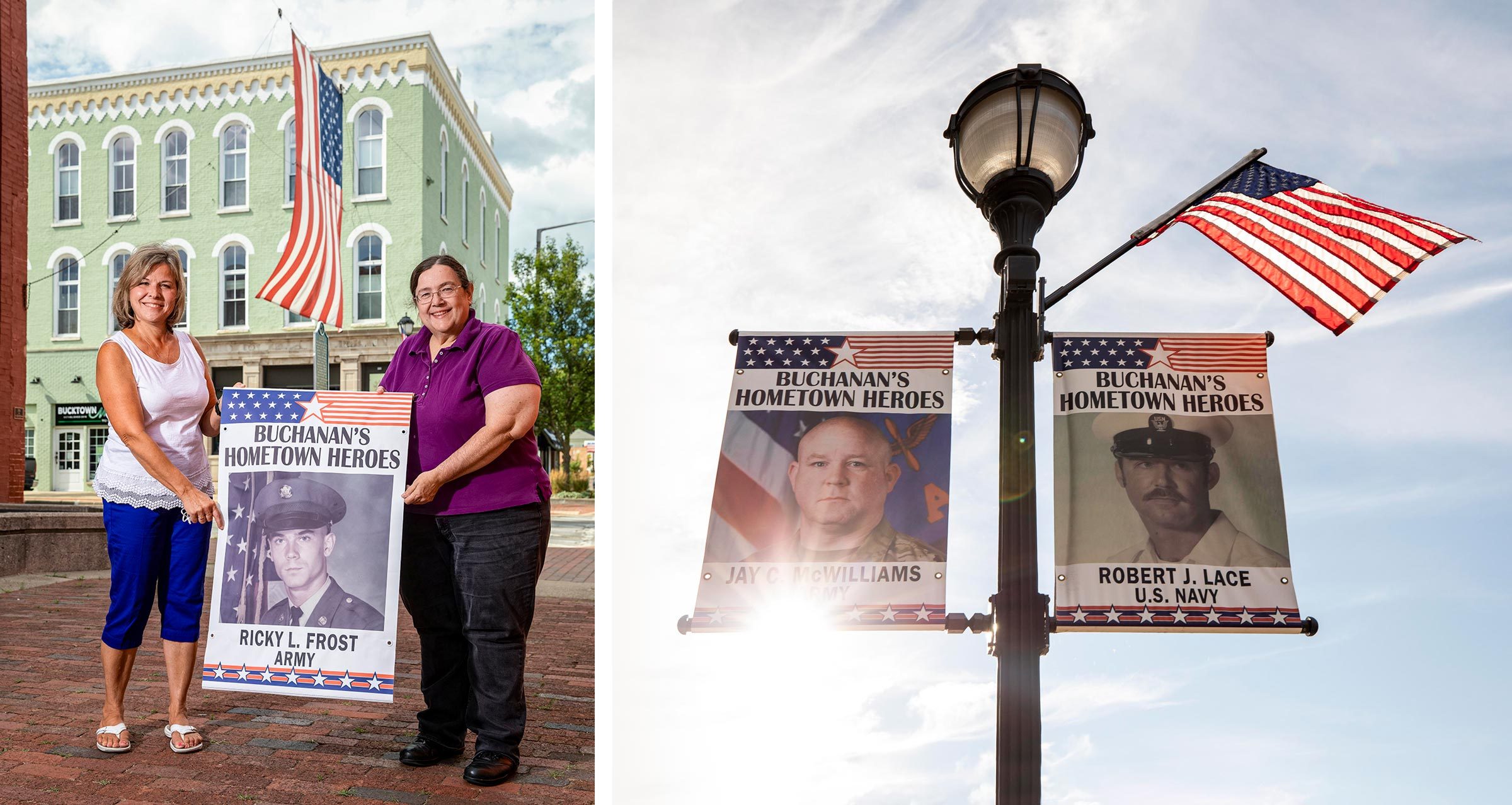
“When the banners appeared,” says city manager Bill Marx, “it provided a little confidence that the whole world isn’t going crazy.”
Lee, whose father and brother both served in the Army, says there is a natural connection between the march and the honoring of soldiers. “Those vets are important,” she says. “They’re the reason we’re able to protest.”
Mickey Frost, 65, had a similar reaction to the marchers walking under the lampposts. Banners for her father, who fought in the Korean War, and her husband, a Vietnam vet who passed five years ago at age 61, hang together on one post.
“What perfect timing, the walk coinciding with this being the first time that these flags have ever hung in the community,” Frost says. “It was meant to be.”

When you arrive in Buchanan from the east on Front Street, you’ll be met by the unofficial town welcome committee: a flock of ducks. A few dozen of them call Buchanan home and are there to greet all those who come. In thanks for their service, the town built a small hut for them to lay their eggs and seek shelter in storms. Another nearby structure houses gumball machines filled with duck food. For 25 cents, you can feed them, a fee the Friends of the Buchanan Ducks club uses to make sure the flock stays fat and happy. Nearby duck-crossing signs on Front Street and Red Bud trail keep the innocent birds safe.
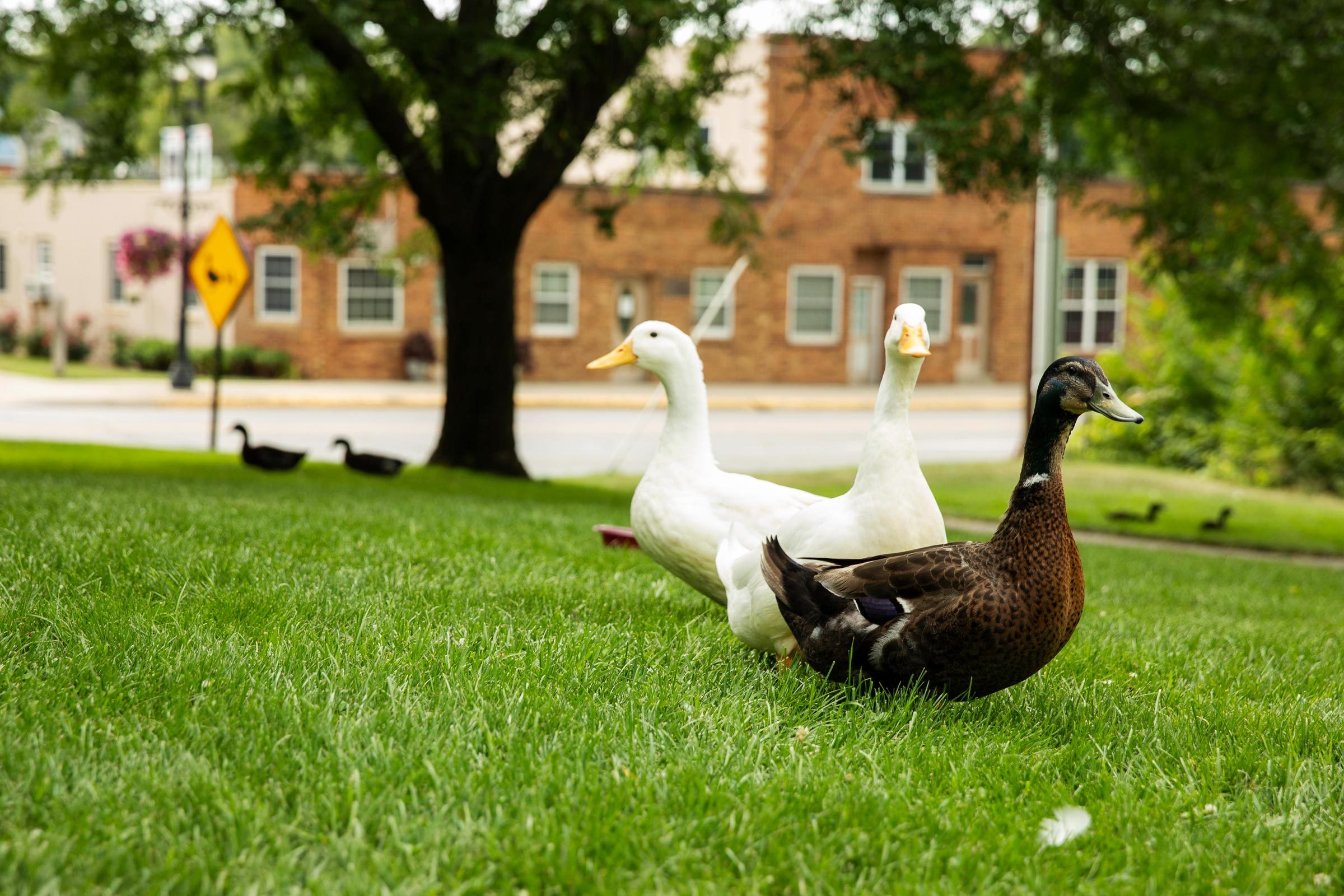
Buchanan’s town motto is “Life is better here,” but economically it has been a struggle for some in recent years. Clark Equipment and Whirlpool once employed thousands, but both are long gone now. The town’s median income is $34,000, compared with $54,000 statewide.
Yet Buchanan’s willingness to embrace the greater good also helped it find an unlikely economic lifeline. After Michigan passed a medical marijuana law in 2008, Buchanan residents spent nearly ten years in contentious but polite debate about whether to allow its sale in their city. In 2017, the city commission finally voted yes. Redbud Roots, a company that focuses on cannabis as medicine, has invested $25 million in the area, building facilities and hiring hundreds of people. When a recreational marijuana law was passed in Michigan in 2018, the city said yes again, bringing more jobs to town.
“I was actually the one no vote for the original ordinance,” says Mayor Moore. “But I’m happy with how things turned out. We’ve done a very good job of protecting the public and at the same time letting the public have access to a product that they are wanting.”
Redbud co-founder David Murray was a hedge funder in Chicago but has since moved to Buchanan to be closer to his growing operation—and because “life is better here,” he says.
Supporting people when they need it most is a time-honored act in Buchanan. It’s the idea that gave rise to the Scarecrow Factory, which is exactly what the name suggests: an assembly line for festive scarecrows. They are handmade—by volunteers whose average age is 76—and sponsored by businesses for $55 a straw-filled head. Last year, they raised $20,000 for local charities. The virus slowed production at the Scarecrow Factory for a time in 2020, but Buchanan quickly came up with another irresistible funding source. Says Mary Fisher, who helped launch the scarecrow tradition in 2007, “This year, we’re gonna sell garden gnomes!”
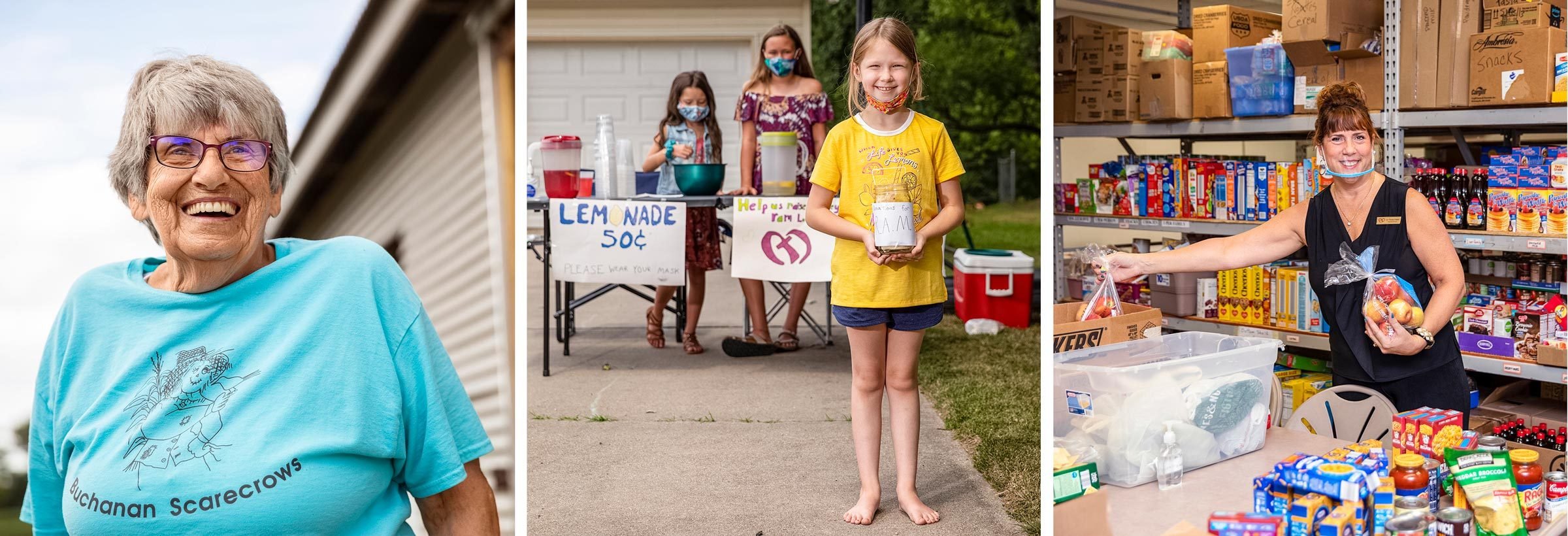
One of the town’s largest benefactors is called Redbud Area Ministries (RAM). (Buchanan is called Redbud City for the vibrant redbud trees that line its streets.) RAM provides food, clothing, employment assistance, and counseling to their “guests” and “friends”—never “the needy” or “clients,” says executive director Jan Nowak-Walters.
Stephanie was one of those guests. She arrived a few years ago with her four-year-old son, fleeing a boyfriend she said abused her and left her with a ton of unpaid bills. RAM negotiated a deal with her landlord, found her a job, and helped her quit drinking. The last time she came to RAM, a few months ago, she told Nowak-Walters, “I don’t need a thing. I just came back to ask for prayer because everything is going well.”
In 2019, Nowak-Walters visited a local Girl Scout troop, showing the girls a picture of empty shelves. Scouts Kate Holloway and Eloise Herrick, both just eight years old at the time, wanted to help, so they organized a food drive. “We restocked those shelves,” says Holloway.
This year, the girls did it again. Their second annual food drive collected more than 1,000 items of food and nearly $1,000 in cash for the ministry.
Another $1,500 came one glass of lemonade at a time, thanks to several stands set up around town by more of Buchanan’s youngest helpers: Delanie Dutoi, 8, Makayla Mitchell, 7, Ava Sears, 10, and Morgan Weldy, 11. At a dollar a cup, that’s a lot of lemonade!
“It just blows my head the support that’s present in this town,” says Nowak-Walters. “I have people that say, ‘Let me know what you need, let me know what you’re short on.’”
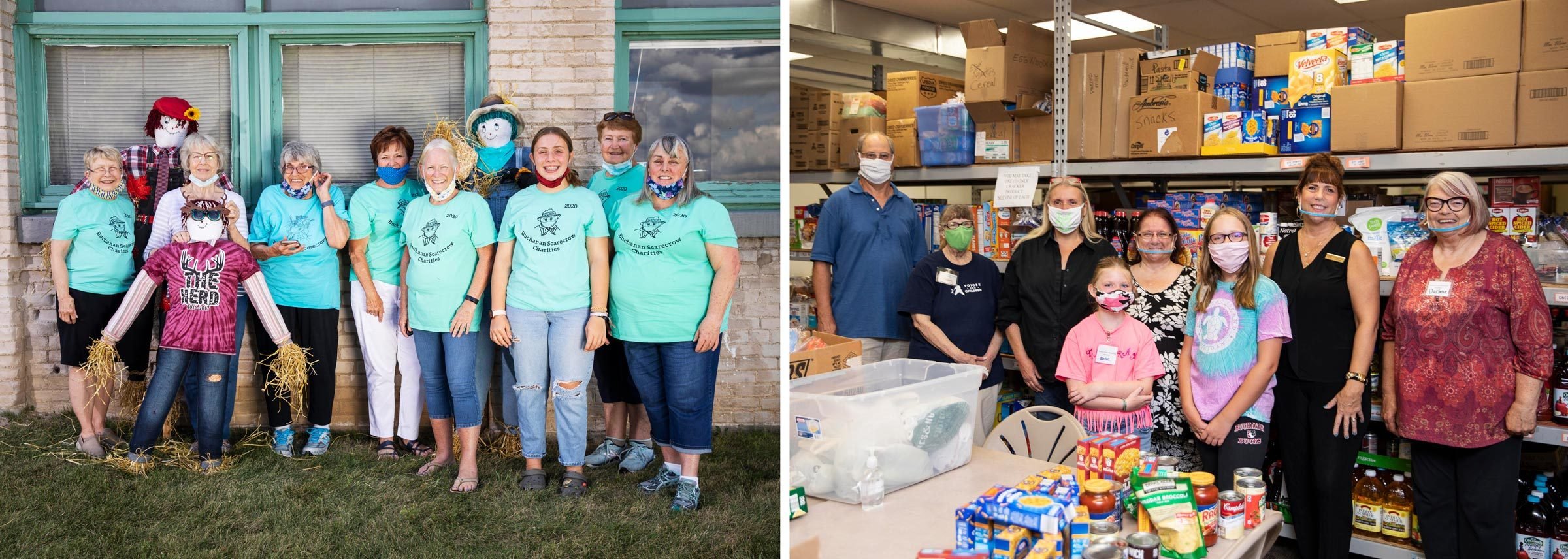
COVID-19 forced RAM to close this spring—temporarily. But volunteers worked day after day to set up work-arounds, retrofitting the RAM offices so people could come in and get counseling and organizing new ways to collect and distribute food.
“We put the best procedures in place and trusted that if we were on God’s errands, we would have God’s protections,” says Nowak-Walters.
In many rust belt towns, young folks can’t wait to grow up and move away. That doesn’t happen as much here, thanks in part to the Buchanan Promise. Modeled after similar initiatives in nearby Kalamazoo and elsewhere, the Promise is a college scholarship of up to $10,000 for anyone who attends Buchanan High for four years and graduates.
Walter E. Schirmer Jr., son of the president of Clark Equipment, left more than $8 million to the future of Buchanan when he died in 2016. The first checks were cut in 2017. The Promise currently supports 300 students, with tuition payments of $600,000 so far. Kadin Mills, the drum major who stenciled the downtown windows, is putting the money toward tuition at Northwestern University.

When Deejra Lee was first planning Buchanan’s Black Lives Matters march, one of her first calls was to Chief of Police Ganus.
“I was prepared for the worst—we could either do this with his help or without it,” Lee says. She was pleased to learn that they had the same goals for the community and the march. “He wanted to make sure he could do everything possible to make it safe for us. He also voiced many times that he thinks there’s something that needs to be done across the country.”
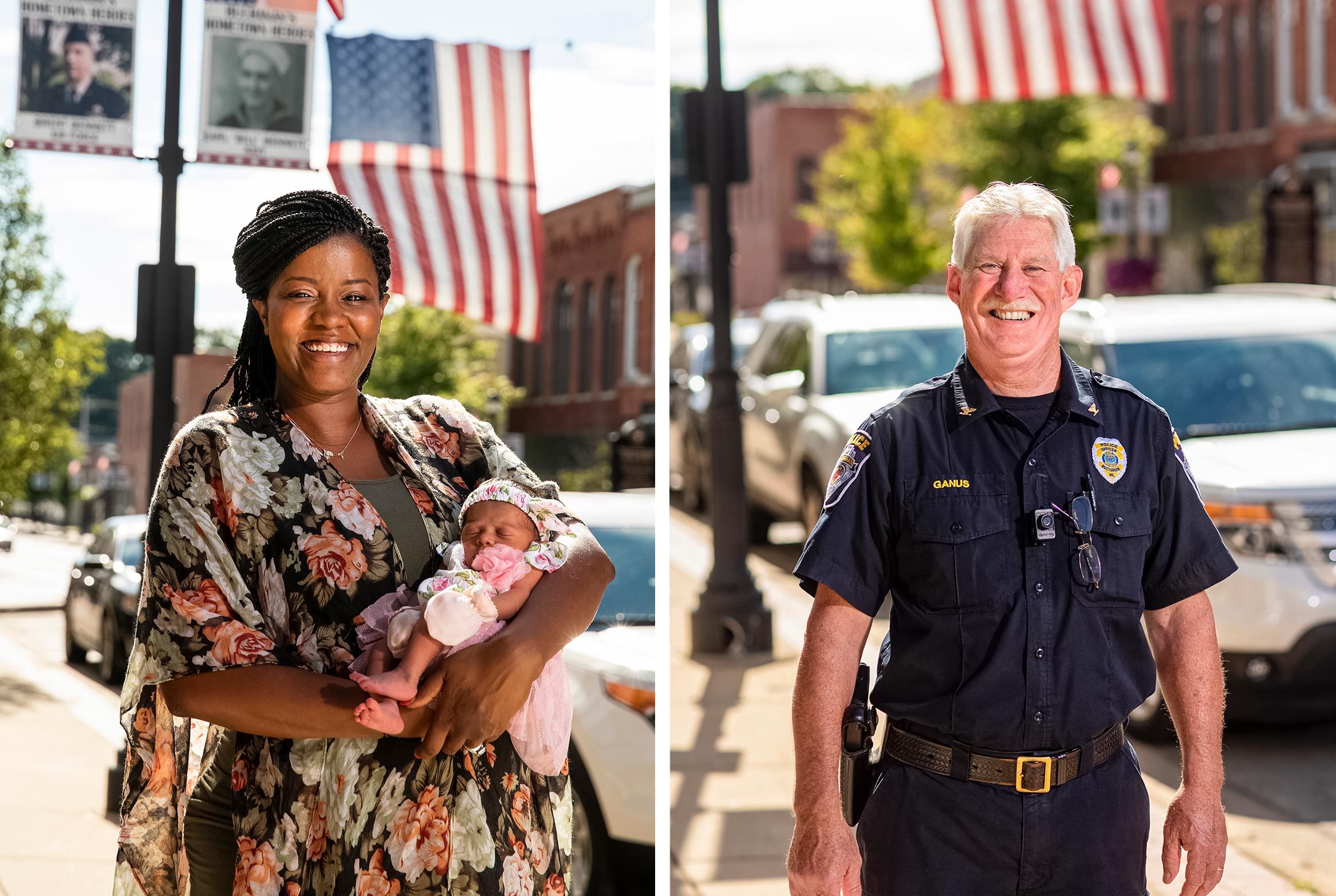
“A lot of people want to know what their police departments think of this event that happened in Minnesota,” says Ganus. “That was a terrible, sickening display of law enforcement. We are totally against that. That’s not how we do business here in Buchanan. We do not stand behind that kind of behavior.”
The call was on June 5. On June 8, the hundreds who gathered at Buchanan High made their way to Front Street, where the banners of their friends and family in uniform smiled down on them. It was nearly 90 degrees outside and as the procession passed Tom Jolly, a local businessman who owns the building where Cannavista Wellness Dispensary is located, he handed out water. The protestors held signs that said “Justice for All” and “Black Lives Matter” and chanted the names of Black people killed unjustly by the police.
When the procession arrived at the police station, the marchers kneeled. Emotions were high.
“You just feel disgust of how long you’re kneeling, how long that ex-police officer kneeled on George Floyd. And anger. But this was a peaceful march,” says Ganus.
While Black people in town say that they have a good relationship with the Buchanan police, Lee, Ganus and the town’s leaders want to make sure that equal justice for all stays the rule. They instituted regular meetings where citizens could air grievances to the police and they remain committed to the community policing model that got them to such a good place to begin with. Each year, the police department hosts a big party for the whole town, with food, entertainment, and the main attraction: a dunk tank where locals can send officers into the drip. They hope to do it again soon, when the pandemic subsides.
“America is made of towns a lot like Buchanan, these tiny little towns just as committed and involved in making America better as people in the big cities,” says Van Dyke, who wanted the world to know about Buchanan, which is why he nominated it as a Nicest Place.
“As a young officer, I was always interested in what New York City was doing, the newest techniques,” says Chief Ganus. “But I think it’s time now that some of these big cities look to smaller cities on how they’re doing things, how they’re connected to the community.”
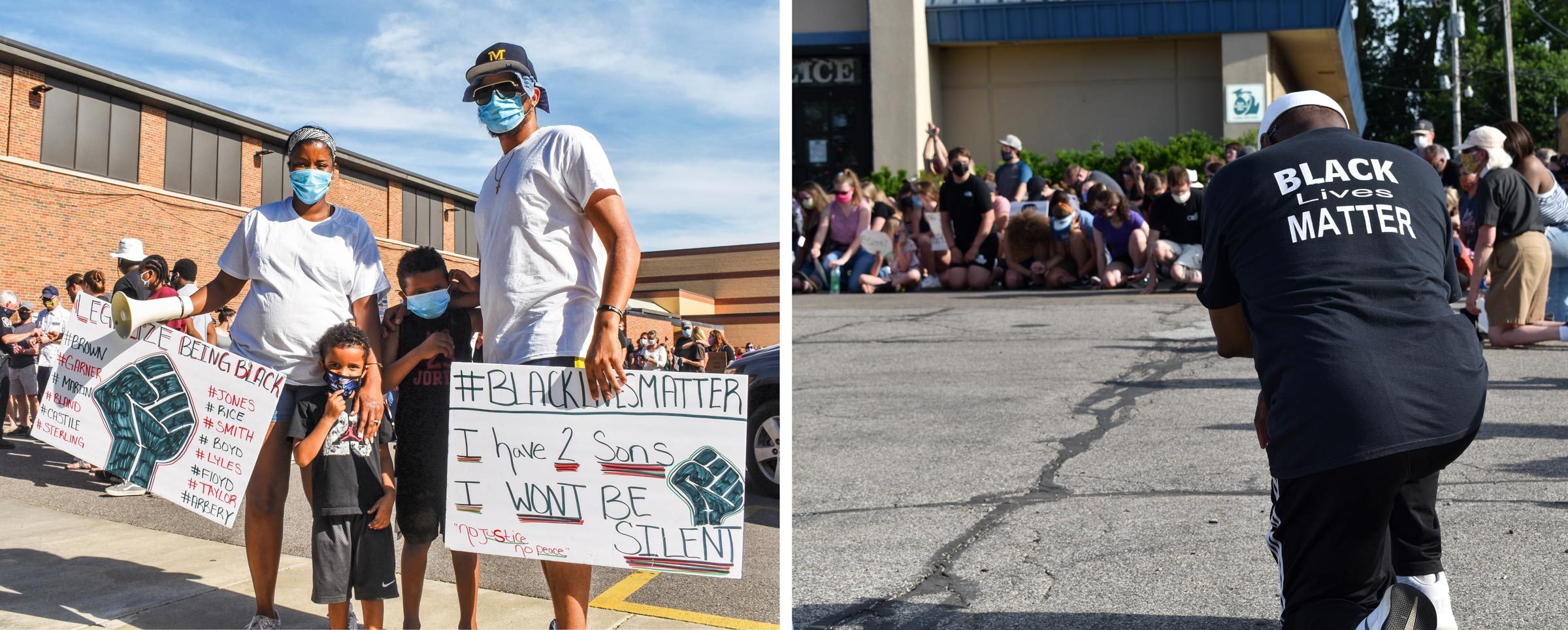
“We hire people with the right attitude. Someone with a bad attitude but the skill set you need— you can’t correct attitudes,” says Moore. “We’re careful with that and I think that’s the key with community policing.”
“We have been very responsive to any questions and criticisms that may be directed our way,” says Marx, the city manager. “We take it seriously.”
After much debate with her husband, Jordan, Lee brought her kids to the march. They helped inspire her to organize it and her oldest, Jordan Jr., 7, was starting to be curious about the world.
“He asked a lot of questions afterwards that made me proud that we included him, like ‘why are we doing this?’ and ‘am I different?’ Those questions are hard for a parent,” she says, “but he’s at the age where I want him to start to be able to understand what’s going on in the world.”
Jaxen, 4, was also there. Dayna, her newborn, was there in Lee’s belly and then born into the Buchanan community a month later.

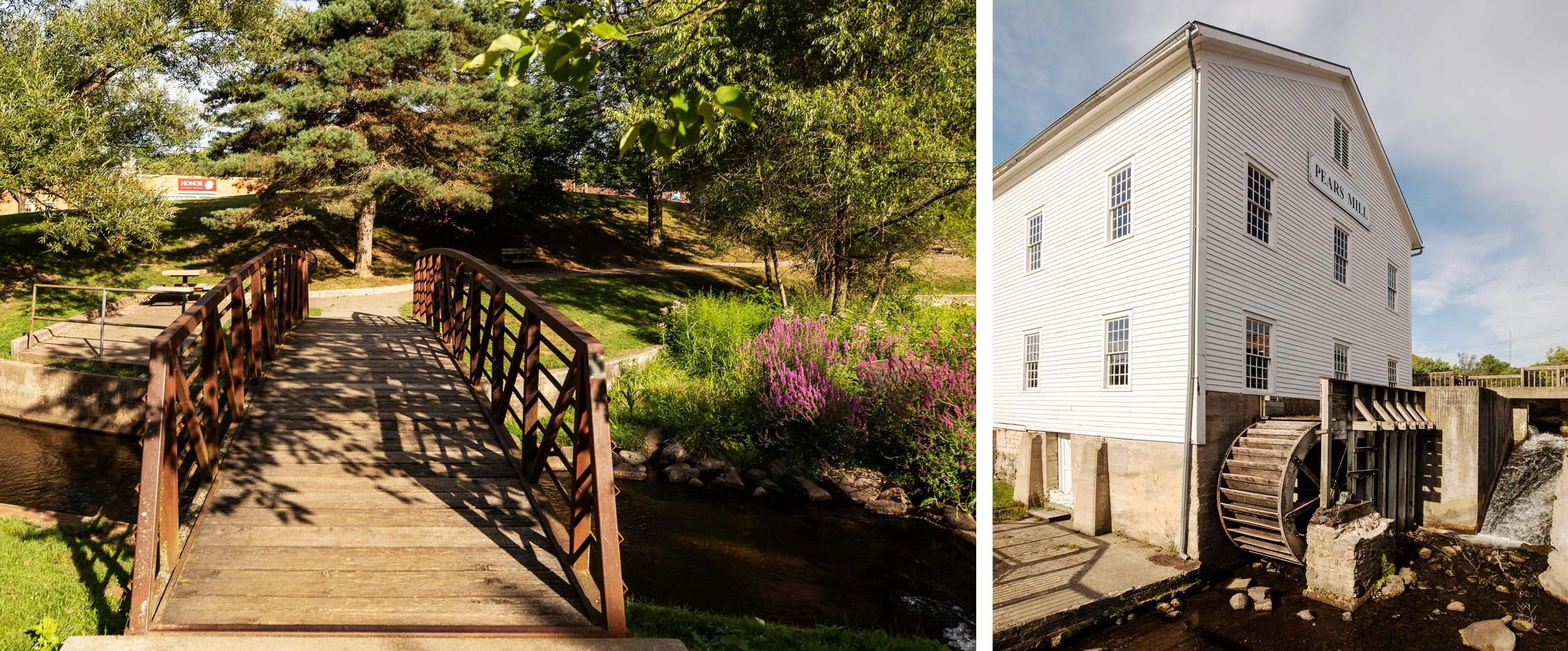
Megan Goodrich, 27, grew up in Buchanan. Her father is Black and her mother White, she says she always felt comfortable living in town.
Like so many who were raised in this year’s Nicest Place in America, she had her own idea of giving back.
“I’ve always loved helping. When I was younger, it was focused on animals. When I was older, it transitioned to people,” she says. Perhaps that’s why she became a home healthcare worker with her certified nursing assistant credential. Caring for people all day at work wasn’t enough to fill her need to pitch in.
After she saw a video about how women experiencing homelessness often lack sanitary products, she asked local businesses to host donation boxes. Some 2,000 donated items and $500 later, neighbors began asking Goodrich, “Are you going to keep doing this?” They wanted to keep it going, and so did she. She’s named her ongoing effort One Month at a Time.
“Buchanan is a very supportive community,” says Goodrich, 27. “If you have an idea and you want to do something, there’s bound to be people here who will try to help you figure out how to make it happen.”
“Make it happen.” If Buchanan didn’t already have a motto, that would do nicely too.

 In neighborhoods across America, people united to overcome the virus and to fight racial injustice. We received nearly 1,200 stories this year from all 50 states. Buchanan was just one of them. You can read 49 more here. We’d like to thank our partner Nextdoor for helping us get the word out and for helping unite American communities.
In neighborhoods across America, people united to overcome the virus and to fight racial injustice. We received nearly 1,200 stories this year from all 50 states. Buchanan was just one of them. You can read 49 more here. We’d like to thank our partner Nextdoor for helping us get the word out and for helping unite American communities.





















